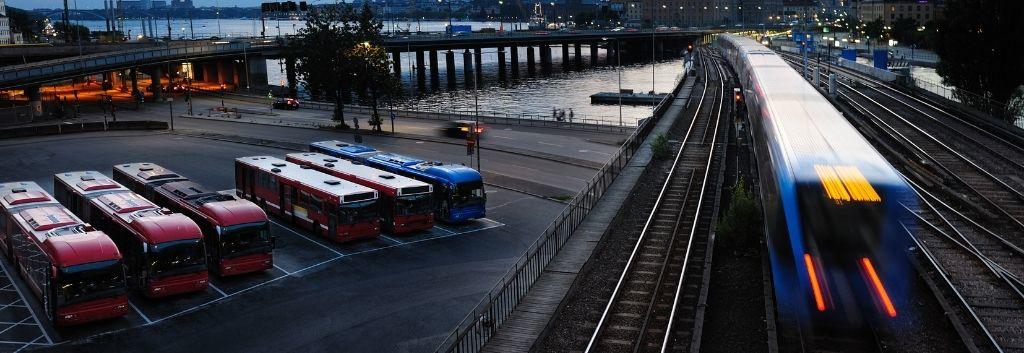
Macnica is engaged in co-creation activities for MaaS business development with the Sotetsu Group, which provides a wide range of businesses and services, mainly in Yokohama City, from transportation to distribution, hotels, and real estate development.
In this article, we interviewed Mr. Takumi Shiozaki, Manager of ICT Promotion, Management Strategy Office, Sotetsu Holdings, and Mr. Junya Takahashi, Assistant Manager, Planning and Safety Department (autonomous driving), Sotetsu Bus. Future town development while clarifying each other's roles toward the realization of attractive town development along the Sotetsu line, such as the current situation and issues, services that utilize autonomous driving technology, promotion of DX within the Sotetsu Group, and creation of group synergy discussing the appearance of
Macnica has been working on the social implementation of autonomous driving and the creation of MaaS (Mobility as a Service) businesses for several years, and has been in conversation with various local governments and companies. We have realized the need for solutions that provide services that utilize mobility, and we have made great progress in developing functions and technologies.
We are also conducting demonstration experiments, but there are still few players who are fully introducing autonomous driving vehicles and providing mobility services. In order to move beyond the MaaS business and beyond, it is important to think about how best to utilize next-generation mobility and put it together. Under such circumstances, we will consider how to create businesses by utilizing next-generation mobility with the Sotetsu Group, which provides services directly to users.
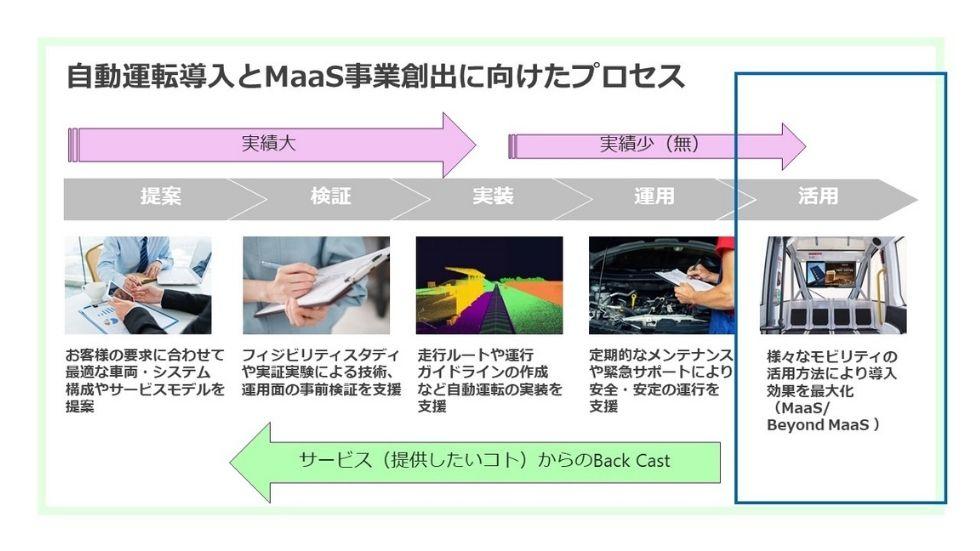
The Sotetsu Group is a corporate group consisting of 33 companies with Sotetsu HD as the holding company. We are mainly engaged in business activities and development in the following four fields: transportation, distribution, real estate, and hotel.
We contribute to the development of local communities by developing services that are closely related to people's lives, such as railroads, housing, and supermarkets. Originally, the railway company "Sagami Railway" had business divisions such as transportation, distribution, and real estate. . As the name suggests, the Sotetsu Line is a railway company that runs in Kanagawa Prefecture, and runs in the eastern part of Kanagawa Prefecture, crossing between Yokohama and Ebina.
A recent major initiative is the “City Center Direct Project”. This is a plan to build a new track that connects each line of the JR line and Tokyu Toyoko line, and to run on each other. As a result, you can go to Shinjuku and Shibuya from the Sotetsu line without changing trains. JR lines have been completed in 2019, and Tokyu lines are scheduled to be completed in the second half of 2022.
Macnica 's MaaS solution
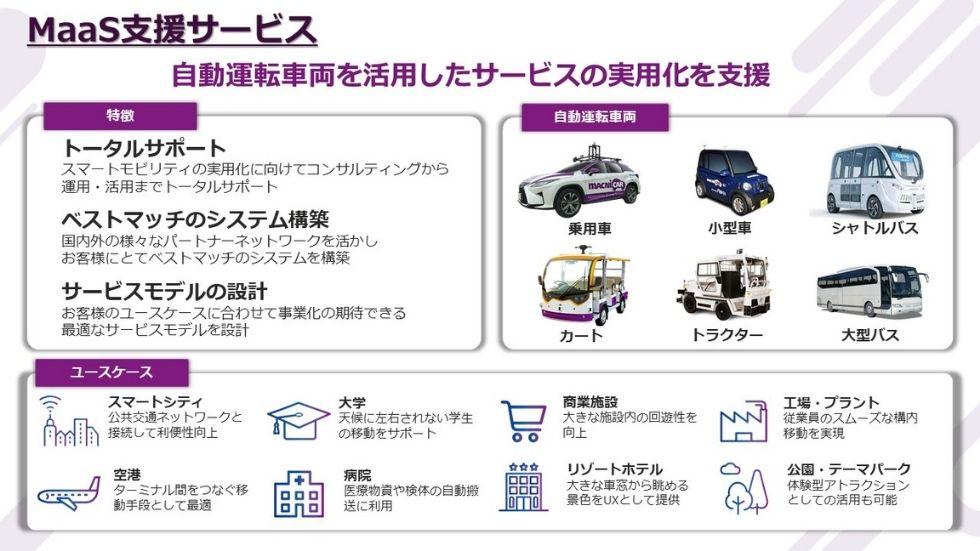
Macnica provides MaaS support services and supports the commercialization of services that utilize autonomous driving vehicles. By leveraging our strengths as a trading company, we can introduce not only passenger cars but also various vehicle integrations such as buses, carts, and tractors, as well as use cases that suit our customers.
It also features total support, best-matched system construction, and service model design. As a service provider, we are also involved in the service model design business and support commercialization.
Regarding autonomous driving, we are currently supporting specific demonstration experiments and regular operation in various parts of Japan as shown below.
・ Sakai Town, Ibaraki Prefecture: Sakai Town, Ibaraki Prefecture is the first municipality to start regular operation of autonomous driving buses
・ Misakubo-cho, Hamamatsu City, Shizuoka Prefecture: Start of public road demonstration experiment with autonomous driving ultra-compact mobility "macniCAR-01"
Sotetsu Bus autonomous driving Efforts
Sotetsu Bus has been conducting demonstration tests of autonomous driving buses since September 2019. Ahead of our competitors, we have been working on a demonstration experiment using our own autonomous driving bus. First, we ran the first large autonomous driving bus as a venue shuttle service for the popular event "Satoyama Garden Festa" in Yokohama City. On that occasion, it carried 5,000 passengers.
Subsequently, in July 2020, we made the shuttle route a closed environment where people and cars could not enter, and conducted a driving demonstration experiment of a large autonomous driving bus without a driver's seat through remote monitoring and operation. It has become a successful example.
In October 2020, as in the previous year, as a shuttle service to the same event venue, in a mixed traffic environment where people and cars normally come and go, a large autonomous driving bus without a driver's seat will be tested by remote monitoring and operation. I was. It was the first successful example of unmanned commercial operation in Japan. By owning a autonomous driving bus in-house and working on demonstration experiments, we were able to receive proposals from technology companies as a result.
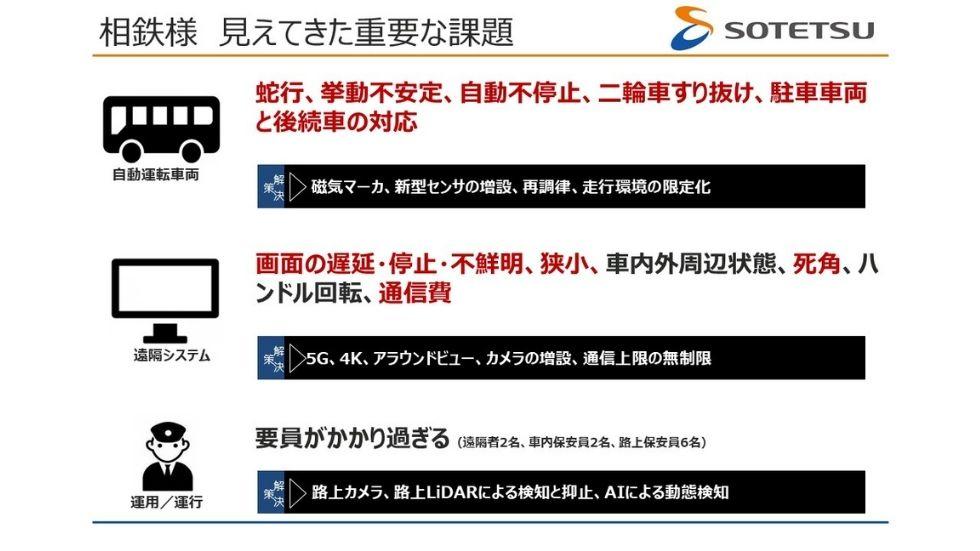
Various problems were identified by actually conducting demonstration experiments. Originally, the purpose of introducing autonomous driving was to improve social acceptance, whether it would be accepted by the local community.
Among the reactions of the passengers, there was no one in the driver's seat. It seems that there was a lot of things, and it was a surprising feeling.
At the same time, I felt like I was witnessing the first moment when new technologies and initiatives blended into the community. However, many problems were found, such as "too many people."
In the case of autonomous driving, since there is no one sitting in the driver's seat, there is no choice but to increase the number of personnel to ensure safety. I have come to see the necessary technology for running unmanned. In reality, the technical elements necessary for autonomous driving are already in place, and the next issue is how to coordinate with the infrastructure according to the location and implement it.
There is also the option of spending more time and money on autonomous driving itself to improve its quality. However, when considering the provision as a commercial service, it will be a very expensive vehicle, so it will be difficult in terms of business feasibility. Therefore, it seems that it will become a realistic method to gradually implement it while coordinating with the infrastructure and limiting the places and speeds where it can travel.
At this stage, Mr. Takahashi says that from the bus operator's standpoint, the bus operator feels that "we have done everything we can to make the autonomous driving."
No matter how perfect a vehicle is, it cannot run without road infrastructure, so it is also an important point of discussion to be able to provide road infrastructure with technology to further improve safety. However, that would deviate from the position of the bus operator. The challenge is whether it is possible to take proactive action on roads that are not owned by the company.
In the future, in order for autonomous driving to be implemented in a manner suitable for society, it is necessary to consider a suitable method of dividing roles and develop a mechanism.
Service concept utilizing next-generation mobility
So, what kind of future do you envision as a next-generation mobility service?
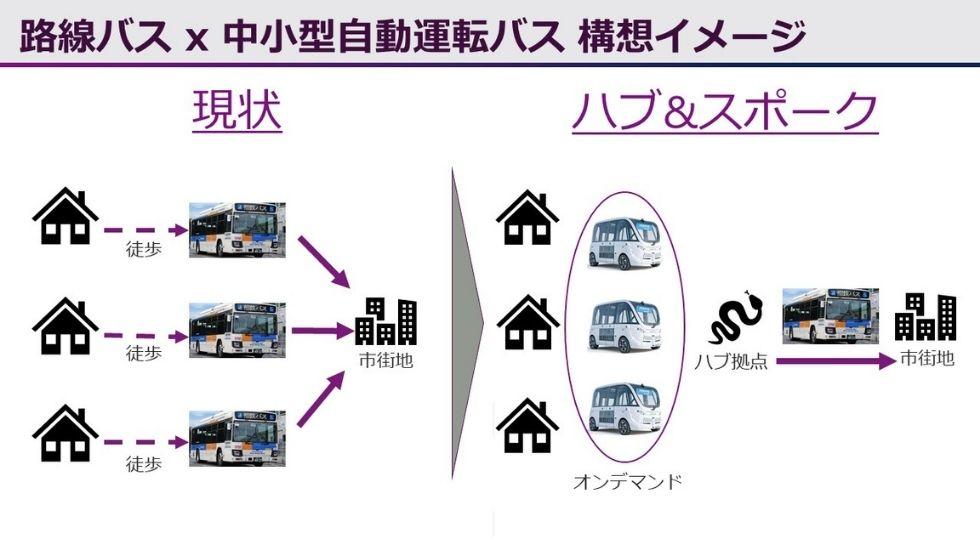
Based on the three demonstration experiments so far, he feels that the hurdles for autonomous driving of large buses are high in terms of "large buses go around the city" and "delivery to customers' destinations." is. This is because it is difficult for a large size vehicle to drive freely on the narrow roads and hilly roads that are common in Yokohama, and the skill of the driver is required.
Therefore, while large buses run autonomous driving on main roads, buses like NAVYA's autonomous driving bus vehicle "ARMA", which Macnica handles, are used to connect to relay points by acting like capillaries. There's a way. It seems that they are also considering ways to mix vehicles according to region and purpose.
Hub spots are not just places where you wait for a bus, but also spaces where customers can relax, such as cafes, and various facilities that are convenient and allow you to use your time effectively. will lead to
If new consumption is born in the waiting space and it leads to economic development, the area will be revitalized and the attractiveness as a living environment will increase. When considered comprehensively, the value of the entire region increases.
In addition, since the Sotetsu Group was originally engaged in businesses such as supermarkets, hotels, and real estate, we believe that we will be able to take advantage of these strengths. In addition, we recognize the need for more cross-sectional collaboration than at present, using the power of digital and technology, for such urban development projects.
The Sotetsu Group is involved in a wide range of businesses that are closely related to daily life, so one customer is involved in multiple businesses. The strength is that we can collect a wide variety of data, so we believe that utilizing such data and co-creating with new partners will lead to the creation of livable cities.
Even now, we are promoting the "Underpass Space Development Plan" co-created by the community and creative human resources, and the "Yumegaoka Large-scale Customer Attraction Facility Development Plan" that utilizes the charm of the region and is interactive and interactive.
As you can see from these businesses, the axis is "region, real". "I would like to continue to use digital technology as a means to increase real value," he said.
Co-creation activities with Macnica
We are currently discussing what we can do in the form of co-creation activities with Macnica, including the assets held by the Sotetsu Group, in order to develop MaaS and our efforts to implement autonomous driving. I think it would be good if we could share the image of our business and continue co-creation.
Today's market is highly uncertain, and consumer preferences are changing in many ways. In such a market, it is becoming difficult for a single company to vertically integrate and mass produce and provide something like in the past.
Therefore, the process of co-creating businesses with many partners by leveraging each other's strengths is essential for our future success. I spoke with the Sotetsu Group this time, but I would like to do the same activities as other companies.
Inquiry
If you have any questions orconcerns regarding this matter, please contact us from the following.
